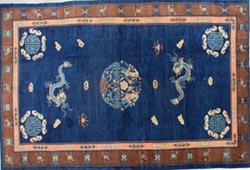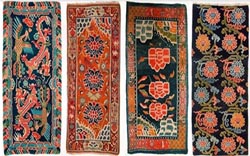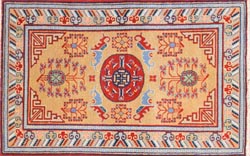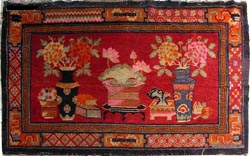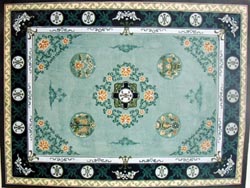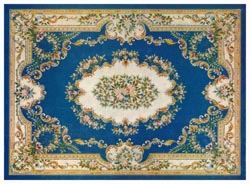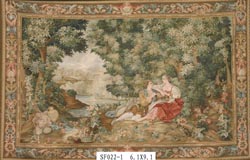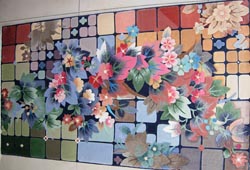|
|
|
As a Chinese traditional hand-made craftwork, carpet weaving is of the long histories. Xin Jiang is one of the major places where the Chinese carpets originated. The climate there is rigidly cold and people live in nomadic life. This created a huge demand of the wool fabric products to keep them warm or even make their life more beautiful. The carpet was firstly structured as plain back knitted, later on the coarse weft tufted fabric texture and much thicker tufted carpet appeared. The Chinese carpet industry was already at quite high and mature level 1000 years ago. In the “Record of Western Countries” by Xuan Zang of theTang Dynasty, Xuan Zang had a vivid description of the carpet prosperity when it was even more than 1000 years ago. With the conquest of the Hun Nation by the Great Han Emperor, the “Silk Road” was established and a lot of the silk carpets, teas, pigments and china products were exported to Europe and Western Asia areas and vice versa. People there then had a chance to understand the Persian carpets as well. Even in today's Persian carpets, there are still quite a lot of designs which are similar to Chinese designs but with Middle East color and styles. Since then, there has been a lot of communications and exchanges between those two ancient nations and eventually the art of the carpet weaving has reached its climax.17th and 18th centuries were a period when the art of the carpet weaving finally reached its climax. The finest carpets were produced and consumed in the palaces and temples. Excellent examples of traditional Chinese carpets are represented in the permanent collections of major Western museums and galleries including the Metropolitan Museum of Art in New York, the Textile Museum in Washington D.C., and the Victoria and Albert Museum in London where they are the object of dedicated research by scholars. In the 20th century, however, modern machine spun cotton and wool gradually came to replace hand-spun yarns, and traditional natural dyes were superseded by artificial chemical dyes. With the opening up and reform policy, China's economy has been developing rapidly and people are becoming more and richer. In this circumstance, there are a lot of people in large cities or Southern part of China who are interested in ancient style decorations and this gives a rise to the further development of carpet. Most places therefore become the center of hand-made carpets, among which Nan Yang, Xing Jiang and Tibet are the typical examples. Even until the middle 80's of the 20th century, most of the carpets are for export only and the Chinese people would think it was too far away for them to enjoy. But since then, people start to live a rich and stable life and are getting more and more familiar with this ancient artwork. Nowadays, many families start to regard this luxurious carpet as the symbol of high cultural taste. The Silk Road includes three routes. The main route starts from Chang'an (now Xi'an) in the east, through Zhangye, Dunhuang, Loulan, Taklimakan Desert, Mali, Teheran, Baghdad, to Cairo or Istanbul. The second route is through Anxi, Xinjiang, Alamutu, Jumbul, to Caspian Sea. The third route: along the Hexi Corridor, through Islamabad, to New Delhi of India. The major tourist attractions along the Silk Road include Xi'an, Lanzhou, Dunhuang, Turpan (Tulufan) or Hami, Urumqi, Etc. The important tourist spots include Loulan Ruins, Mogao Grottoes, Majishan Grottoes, and culture and custom of the minorities in the Western Regions. NanYang Silk Carpet Nan Yang is located in the south-west area of He Nan Province where the silkworm raising is quite popular. The main advantage of silk there is of long fiber with strong resilience, high tension and fine touch, therefore it's especially suitable for use to produce high quality silk carpets. With fine workmanship and elegant designs, Nan Yang Carpet enjoys high reputation among the in-house decorations and is of high value both practically and from the art viewpoint. In 1980s the real silk carpet manufacturing is developing rapidly in Nan Yang and it's now been the largest place for this industry in the world. Each year more than 80% of the high quality carpet is manufactured there and with quality equal to what's made in Iran. The Nan Yang “1000 lines Silk Carpet” is known as the “King of Carpet”. But after 2000, hand-made silk carpet industry declined in output in a large scale in Nanyang. XinJiang Carpet The Xin Jiang carpet has a history which is over 3000 years and is famous for its superb quality, dense pile, flat surface and elegant designs in the world. It's hand-knotted and woven with local superb wool which is called as He Tian Wool. The primary advantage of the He Tian Wool is of high elasticity, tension and brightness and is very suitable for carpet weaving. The pigments used are also taken from the plants i.e. safflower, madder, indigo, Chinese Scholar tree pods, pomegranate bark, and some mineral materials. Therefore, the colors are always bright and never faded. Xin Jiang carpets have common features in the pattern and design which is typical of local characteristics. It's with variously sized laces in multi-layer width, centered with geometrical two-square or four-square patterns and dotted with various auspicious pictures i.e. flowers, branches and leaves and auspicious animals.etc. This structured design gives a life to the carpet itself and makes it look vivid and metrical. Tibetan Carpet The wool produced in Tibet is rigid and elastic, which is suitable for making the carpet as well.The Tibetans shear the wool of their mountain sheep, which in some cases are home bred. The exceptionally resilient, lustrous wool, mostly hand spun, is basis for the success of this carpet. The Tibetans have developed their own system in knotting. The work is done on vertical looms. Into the cotton warp the weft thread is slung over a shed stick of 5mm thickness. When the entire knotted row is finished the loops are cut open and form a bristle like pile. Due to this procedure, productivity is increased, and the loss of material is minimized. In Tibet, Jiang Zi area is the place where the highest quality carpets are produced. It's of the fine workmanship, bright design and durability and has a history of over 600 years. Jiang Zi Carpet can also be called as the Jiang Zi Kardian in terms of the sizes. Generally, those with sizes larger than 18 square feet are called as the carpet and those with smaller sizes are called as the Kardian. This carpet usually uses cotton as the warp and wool as the weft yarns and dyed with acid pigments. Some also use the plant juice and colorful mineral materials and its chief advantage is brightness and will never fade. The traditional design of the Jiang Zi carpet usually follows temple frescos i.e. “Two dragons are playing with a pearl”, Mountains and Rivers and some other designs. Nowadays there are more designs such as the Potala Palace, Everest, the Great Wall, the bridge of the Nan Jing Yangtze River and this is highly welcomed by the customers from all over the world. Other carpet producing area: Last century Baotou in Ningxia produced antique imitation wool rugs, Beijign and Tianjin produced 90 lines woolen rugs, Dezhou in Shangdong produced Aubusson flat weave wool rugs, Jiangsu and Zhejiang produced 120lines spun silk rug. However the production scale is very small now. Patterns of Chinese carpet The Chinese handmade carpets have a lot of varieties and elegant designs and patterns and different styles. The main representative patterns are traditional artistic “Beijing Style” , “ Antique Style ” and “Classical Style ” .There are also “ Antique Imitation Style ”, “ Floral Style ” , “ Jingcai Style ” and various modern floral patterns with the subjects of flowers as well as the “ Persian Style ” modeled on the patterns of ancient Persian carpets ,etc. “Beijing Style” patterns are traditional forms developed and formed through a long period of time, and have absorbed the artistic formations from Chinese paintings, architecture, brocade, embroidery with the abundant cultural connotation, They are consisted of classical patterns such as the flowers in auspicious or legendary meaning, beasts, utensils, Chinese characters and geometric motifs, etc. The colors are sumptuous and elegant. “Antique Style” and “Classical Style” patterns and designs are extend and development of the “Beijing Style” figures. They are designed with the applications of the arts of ancient painted potteries, bronzes, lacquers, carvings on brick and stone, ceramics, embroidery, brocade and Chinese paintings, and with the combination of the carpet weaving technology, market demands and contemporary artistic standards. They have become main designs and patterns of Chinese silk and wool carpets since 1980s. “Antique Imitation carpets”, being also called the carpet modeled on the ancient carpets, are made of the natural silk and traditional technology by applying the traditional art styles of folk carpets in the Northwest China and Court with auspicious or happy and celebrating event contents or with the peonies, beats and round-flowers as their subjects, matching with the wavy and swastika (symbol of good luck) geometric side decorations with ground beige and blue color. The patterns and designs are unsophisticated; and the shapes are simple and highly decorative, having the profound characteristics of Chinese folk arts. The “Floral Style” patterns and designs are composed of the luxuriant and colorful flowers. The shapes are made by using the traditional Chinese realistic painting characterized by the brushwork and polish-up to make the motions realistic and vivid, the structures vivid and easy, and the colors fresh and lucid. “Beijing Style” patterns are to add the side decorations in the “Floral Style” patterns infusing with the patterns of Beijing style, increasing the tableau contents and layers so that the patterns would become more abundant and the forms would have more varieties. The “Persian Style” , namely being modeled on the Persian patterns, is a kind of the closest and finest patterns and designs of ancient Persian carpets that are well-known with their fineness, focusing on the practical use, carpet demand for indoor space and patterns allocation tufted in sub-regions and sub-layers, orderly unfolding and leveling on the carpet surface. The motifs are closed but not in mess; the colors are brilliant but not gaudy with the distinct primary and secondary, gentle and comfortable. Since the end of twentieth century, a large number of exquisite and modern floral patterns with the profound contemporary features have emerged in the patterns and designs of Chinese silk carpets in the respective regions. The figures are easy-going and comfortable; The flower shapes are designed in realistic tradition of painting or realistic painting combining with decorations; The colors are gentle, light and variable; The patterns and designs are fresh and unique, such as: “ Fanhua Sijin ” means“ multitude of blossoming flowers are gorgeous and graceful; “Zhifan yemao” means “ mass of branches and leaves ” ; “ Niaoyu huaxinang ” means “ birds are signing and flowers are giving forth their fragrance ” ; “ Huatuan Jincu ” means “ bouquets of flowers and piles of silks ”. These beautiful motifs relate to traditional Chinese culture and express the tastes of Chinese. 中国手工地毯: 地毯编织是中国的一项传统手工工艺,具有悠久的历史.新疆是中国地毯的主要发源地之一.那里气候高寒,人们过着游牧生活,需要大量的手织品以防湿御寒和美化生活,因而出现了用羊毛或驼毛捻成线,按照古老的编席方法编织出有美丽花纹衬托的各种毯类,即组织结构为平纹的编织地毯,后来发明了过粗细纬,栽绒组织结构,编织加厚密的栽绒地毯即手工打结地毯.1000多年前,中国的地毯编织工艺就已经达到了十分成熟的水平.玄奘的<<大唐西域记>>里,记录着一千多年前当地地毯业兴盛的情况.1959年,从和田地区民丰县出土的古代地毯残片便是最好的证明,它的编织方法与现在当地民间地毯编织工艺基本相似,结扣采用细致的马蹄扣(土耳其结法),经纬密度为330道,仅比现在和田地毯经纬密度360道少30道左右.汉代,随着汉武大帝消灭了匈奴人,一条通往西亚,欧洲的贸易通路-丝绸之路开通了,丝绸之路不仅运载了丝绸,地毯,瓷器,茶叶和香料也促使了东西方文化的交流和传播.中国地毯编织工艺从而随着中国的丝绸之路经过中亚带到了中东和欧洲,同时也让中国人见识了代表波斯文明的波斯地毯,在波斯地毯图案中,至今仍然保留着许多与中国地毯图案完全相同的花纹.也有人认为这类地毯起源于中国,只是在波斯设计师的手中,经过精心的修改并加进了波斯的色彩,从而成为具有中东风格的图案.从那时起这两个文明古国不断相互学习交流与借鉴,传统的中国图案和传统的波斯图案,以及编织工艺在天长日久中相互融合,从而成就了一项高雅细腻的地毯艺术.在十七,十八世纪的明末清初,中国手工地毯制造工艺达到了前所未有的高度,且消费多在宫廷和寺庙中.在这期间产生了大量美轮美奂的地毯,在许多国家,中国地毯被作为永久的艺术品而收藏.比如纽约的大都会博物馆,华盛顿特区纺织博物馆,加拿大皇家昂特里奥博物馆,伦敦维多利亚博物馆等都藏有中国地毯.但是进入二十世纪以后,中国地毯自古以来所使用的手纺纱被机器纺纱代替,天然植物染料被合成的化学染料取代,采用现代手段批量加工地毯,摒弃了传统手工工艺.中国改革开放以后,由于外贸出口的需要,特别是近几年来,中国国力的增强,人民安居乐业,沿海及大中城市中追逐高档古典的装饰风格也有不同程度的需要,因此中国手工地毯出现了前所未有的发展,涌现出许多的手工制毯中心.中国手工地毯从生产地可分为南阳真丝地毯、新疆地毯、西藏地毯. 南阳真丝地毯:南阳地处豫西南地区,这里“比户业蚕,桑荫遍野”,南阳的桑蚕业,缫丝业非常发达.南阳蚕丝纤维细且长,强度高弹性好,光泽强,手感好,非常适合织制高道数,花纹细密的高档丝毯.南阳真丝地毯做工细腻,图案精美,色彩典雅恬静,手感柔软而富有光泽,轻巧耐用,是高档的室内装饰品,具有极高的实用和艺术欣赏价值,南阳地毯多以波斯图案为主,1980年后真丝地毯在南阳飞速发展,这里在90年代已经成为世界上最大的手工真丝地毯生产基地,每年生产出全球80%的高道数真丝地毯,而且已经在质量上可以和伊朗媲美.所产的1000道手工真丝地毯号称“毯中王”.不过2000年后产量大大萎缩,相当一部分质量大不如前. 新疆地毯:新疆地毯已有3000多年的历史,是世界上手工编织地毯的起源地之一,新疆地毯以质地精良,绒头密集、毯面平整、图案繁谨而驰名于世.采用手工打结编织,原料以本地产的优质羊毛-和田羊毛为原料.这种羊毛粗而不粘,坚韧而富于弹性, 具有耐拉、耐压、光泽好、强度大的优点,最宜织毯.染色多采用天然原料,如红花、茜草、靛蓝、槐米、石榴皮、乌尔丹和一些矿物质为原料,色泽艳,久不褪色. 新疆地毯的图案和颜色具有鲜明的民族特点和浓厚的地方色彩.有多层宽窄不同的大小边,中心部分大多是几何形的二方或四方连续,中间内添加各种巴旦姆花,四瓣花,石榴花等变形的花卉、枝叶、瑞兽等吉祥纹样,结构严整而富于韵律,活泼多变而富于生活情趣.从色彩而言,多半是同类色或对比色并置排列,在对比中充分显示各种色彩的个性. 历史上,新疆地毯以贡品,商品而传入中原.今北京故宫博物院织绣馆珍藏的大量新疆高级裁绒毛毯,丝毯,盘金毯,盘银毯,都是清代时由新疆进贡的.至今英国伦敦,美国华盛顿,德国法兰克福等地博物馆,也都收藏着新疆羊毛地毯或丝毯,丝毛混织地毯,作为珍品供人们欣赏. 西藏地毯:藏毯是中国重要出口商品之一,它是以藏系羊毛为原料,沿用藏族的传统工艺,手工纺纱,植物染色,手工编织而成.图案简洁自然,色彩淡雅古朴粗犷给人以一种自然美的享受,迎合了当代世界返朴归真,返回大自然的潮流,深为世人所青睐. 西藏地毯以江孜地毯最负盛名.另外拉萨,贡噶,浪卡子,朗县,丁青,察雅等地也出产的地毯,江孜地毯已有600多年的历史,它纺织精密,经久耐用,花纹富有民族传统,颜色鲜艳夺目. 江孜地毯也叫江孜卡垫.一般说,面积大于18平方尺的称为地毯,小于18平方尺的称为卡垫.江孜地毯最早是从岗巴县的嘎西传过来的,后来从江孜又传到全区各地.江孜地毯以棉纱作经线,以毛线作纬线.染料除国产的酸性染料外还用野生植物的汁,矿石,色土等配成三十六种不同颜色.江孜地毯的特点是颜色鲜明,不褪色.江孜地毯的图案,最初以古老的寺庙壁画为主,主要有二龙戏珠,花草鸟兽,山水古画等.近年来,江孜地毯在花色品种方面,有了很大的进步,能织出大型的布达拉宫,珠穆朗玛峰,万里长城,南京长江大桥等图案,受到了客商的喜爱和好评. 其它产地:上世纪宁夏的包头出产仿古毛毯,北京和天津生产90道羊毛地毯,山东的德州生产奥巴松地毯,江苏和浙江部分地区生产120道绢丝地毯.不过现在产量和规模微乎其微. 中国地毯图案介绍:中国手工地毯品种繁多,图案精美,风格各异.有传统艺术风格的“北京”,“古纹式”,“古典式”.仿民间和宫廷艺术风格的“仿古地毯”,以花卉为题材的“彩花式”,“京彩式”和各式现代花卉图案, 以及仿古波斯地毯图案的“波斯式”等. “北京式”图案,是我国地毯经过漫长发展形成的传统样式,它吸收了中国绘画,建筑,织锦,刺绣等艺术形式.文化内涵丰富,由吉祥寓意和典故的花卉,动物,器物,文字,几何纹样等传统图案组成.图案工整对称,造型严谨,色彩华丽而典雅具有庄重古朴的艺术特色. “古纹式”,“古典式”图案是“北京式”图案的延伸和发展.采用彩陶,青铜器,漆器,石刻砖雕,陶瓷,织绣,绘画等艺术,结合地毯工艺,市场需要与现代审美要求进行设计,成为我国二十世纪八十年代,丝毛地毯的主要图案. “仿古图案”又称仿旧毯.用天然纯丝,传统工艺织做,采用西北民间文化艺术元素和宫廷艺术的传统风格,以吉祥喜庆为内容,牡丹,动物,团花为主题,配以回纹,万字等几何纹边饰,通常以驼色,蓝色,棕红色为主,图案古朴,造型简练,装饰性强,给人以古色古香,古朴典雅的感觉, 极具中国民间艺术特色. “彩花式”图案,以丰富多彩的花卉组成,用工笔画润色法造型,形态写实生动,结构活泼自由,色彩清新明快“京彩式”图案,是在“彩花式”图案中加入边饰,与“北京式”图案融为一体,增加画面内容和层次,使图案更加丰富,形式更加多样. “波斯式”图案,即仿波斯图案.是一种精密细致的古波斯地毯图案,以细密著称,并以实用为前提注重地毯在室内空间的需要,图案分区分层,有序的平展于毯面,花纹密而不乱,色彩明而不艳,主次分明,调和舒适. 二十世纪以来,中国各地丝毯的现代图案设计涌现出许多极具时代特色,精美的现代花卉图案,构图舒展,花型写实或写实与装饰结合,色彩调和淡雅,富于变化,图案新颖而别致.有如繁花似锦,瑰丽多姿.有以崇尚自然为题材,枝繁叶茂,生机勃勃.或鸟语花香,令人神往.或以和平为主题,花团锦簇.或幽静,或安宁,极富情趣. |









